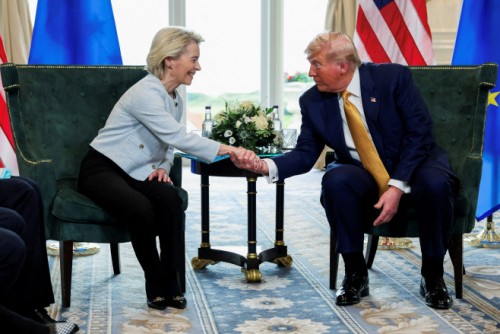 |
| U.S. President Donald Trump (right) shakes hands with European Commission President Ursula von der Leyen in Turnberry, Scotland, on July 27. / Source: Reuters, Yonhap News |
The United States and the European Union reached a landmark trade agreement on July 27 under which the U.S. will impose a uniform 15% tariff on EU goods — halving its earlier 30% threat — while the EU committed to purchasing $750 billion worth of U.S. products and investing an additional $600 billion.
President Donald Trump, after meeting European Commission President Ursula von der Leyen at Trump Turnberry Golf Resort in Scotland, declared the deal “the biggest trade agreement in history.” The new tariffs will apply broadly to EU exports to the U.S., including automobiles.
“This is a massive and consequential agreement between the world’s two largest economies. It brings stability and predictability,” von der Leyen said.
According to Trump, the EU will purchase $750 billion worth of American energy products over three years and invest more than $600 billion into the U.S. economy. He added that the EU will also buy “a significant amount” of American military equipment. However, EU officials declined to disclose exact annual figures in their statement to the press.
Trump emphasized that EU nations would not impose tariffs on U.S. goods, stating, “We’ve opened up what were essentially closed economies across Europe.”
Trump confirmed that EU automobiles exported to the U.S. would now face a 15% tariff, down from a previously scheduled 25%. Exemptions apply to key sectors — steel and aluminum will continue to face 50% tariffs, and pharmaceuticals and semiconductors will not be taxed under the new structure.
Von der Leyen, however, asserted that the 15% rate would apply broadly — including to automobiles, semiconductors, and pharmaceuticals — contradicting Trump’s earlier suggestion that medicine would be excluded. “Regarding the EU, we agreed to a 15% tariff on pharmaceuticals,” she reiterated.
The two sides also agreed on reciprocal tariff exemptions for certain “strategic items,” including aircraft and parts, selected chemical products, generic drugs, semiconductor equipment, specific agricultural goods, natural resources, and critical raw materials.
“We’ll continue working to add more items to this list,” von der Leyen said.
Trump had warned earlier this month of 30% tariffs starting August 1 if negotiations failed. The EU had prepared retaliatory tariffs on key American exports. But with just five days left, the two sides reached a breakthrough, avoiding a transatlantic trade war.
The deal closely resembles the U.S.-Japan agreement struck on July 22, where Japan agreed to invest $550 billion in the U.S. in return for a 15% tariff on its goods.
The U.S.-EU agreement sets a new benchmark for South Korea, which is currently in trade talks with the U.S. Deputy Prime Minister and Finance Minister Koo Yun-cheol is expected to meet U.S. Treasury Secretary Scott Besant in Washington on July 31. Observers say Korea’s minimum goal will now be to secure a similar 15% tariff level.
However, reaching an agreement may hinge on Korea’s investment commitment, which could run into the hundreds of billions of dollars.
Foreign Minister Cho Hyun is also expected to meet Secretary of State Marco Rubio in Washington on the same day to support the negotiations.
Earlier, Industry Minister Kim Jung-kwan and Trade Negotiation Chief Yeo Han-koo met U.S. Commerce Secretary Howard Lutnick and USTR representative Jamieson Greer in Washington on July 24. They extended their stay and traveled to New York for additional talks at Secretary Lutnick’s private residence on July 25.
Most Read
-
1
-
2
-
3
-
4
-
5
-
6
-
7





















